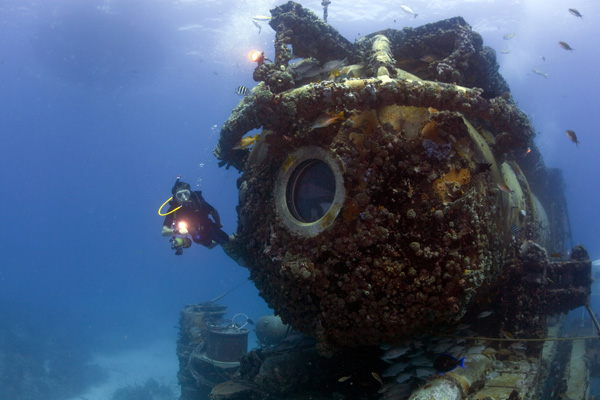Take 5: A ‘Nor’Easter’ on Florida’s tropical shores?

This story is part of an ongoing series highlighting Northeastern’s research efforts at Mission 31. Full coverage.
For the next two weeks faculty, students, and staff from Northeastern University’s Urban Coastal Sustainability Initiative and led by professors Mark Patterson and Brian Helmuth are taking part in Mission 31. Explorer and cinematographer Fabien Cousteau, the grandson of legendary marine explorer Jacques Yves Cousteau, is leading the monthlong underwater expedition. But how and why did a Northeastern team from the chilly shores of New England end up bringing a “Nor’ Easter” to the tropical shores of Islamorada, Florida? Here, Helmuth and Patterson discuss their motivations and excitement for joining forces with the project.
1. A childhood dream come true. Mission 31 honors the work of Fabien’s grandfather, the famed explorer and ocean advocate Jacques Cousteau. More specifically, M31 celebrates the 50th anniversary of “Conshelf II” in which Cousteau’s team lived on the bottom of the sea for 30 days. Today, the only undersea “habitat” is Aquarius, located in the Florida Keys and operated by Florida International University. We serve as Cousteau’s science advisors and have both previously used Aquarius extensively for our research. But even more importantly, neither of us would have become marine biologists without the influence of Jacques Cousteau when we were children. Working with “JYC’s” grandson is a natural fit, and the opportunity to excite younger generations in the same way that we were drawn to ocean science is an opportunity that was simply too good to pass up.
2. Cleaner, smarter, safer coastal communities. In many ways, the themes of Mission 31 are a perfect fit with those of Northeastern’s UCSI. Both focus on the effects of climate change and on the intricate connections between humans and the environments in which they live, and specifically in understanding how we can live sustainably on the shores of vulnerable coastal environments. Florida’s reefs are, sadly, an example of what can go wrong when we don’t pay attention to what is happening in coastal communities and are far from pristine. But in a way, that is a plus: if we only study rare situations of ecosystems comparatively free from human impact, we will never understand how we can live sustainably as part of the natural world.
3. High tech marine biology on the sea floor that can be shared with the world. Fabien’s passion for the ocean and for the use of modern tools to share the excitement of ocean exploration is infectious, and our crew has likewise caught the bug. The Northeastern team—which includes the two of us as well as two research technicians, four graduate students, and two aquanauts—brought more than 20 crates and boxes of high tech equipment to study coral reef health, as well as camera and video equipment to share the experience with the world. Starting with a series of events orchestrated with the Museum of Science, we will be able to share the excitement of Mission 31 as a truly immersive (pun intended) experience.
4. Exploring climate change effects on threatened organisms. Studying animals like mussels, oysters, and lobsters that can be picked up at any seafood store is one thing, but how do you study an animal that may date to the time of King Arthur? We will adapt methods that we’ve developed to study the biology of New England shellfish to studying the biology of centuries-old giant barrel sponges, without ever having to touch the creature. Using high tech oxygen sensors, water flow meters, and equipment more often seen on an operating table, we will study the health and physiology of corals and sponges, as well as the food that they eat—microscopic zooplankton for the corals and bacteria for the sponges.
5. A “library of Alexandria” of marine DNA. Northeastern recently joined forces with the Ocean Genome Legacy, a public repository of DNA from thousands of marine animals. This extraordinary data set includes collections from around the world, and Cousteau’s team will collect samples from sponges that will be archived at Northeastern along with extensive environmental data that we collect while we’re here. You never know—the next cure for cancer, or the next surgical adhesive, may lay within a few feet of the Aquarius habitat. By archiving this DNA, we hope to ease the work that biomedical researchers must do to find these novel genes while the reef is still here.